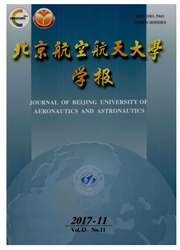

 中文摘要:
中文摘要:
论述了热电材料低维化和器件小型化的发展趋势以及在航空航天领域的应用.利用磁控溅射的方法,在柔性衬底聚酰亚胺(PI)上制备了热电薄膜材料,并对其微观结构和性能进行了表征,结果表明:P型Bi-Sb-Te和N型Bi-Te-Se薄膜均表现出(015)的取向性.利用ANSYS有限元模拟软件热电耦合场分析单元对面内型薄膜热电制冷器进行了模拟,讨论了器件的工作电流和材料物性参数对器件制冷性能的影响,发现通过减小基底的厚度和热导率,可增大基底面内方向的热阻,实现热流沿热电臂的传输;基底的镂空设计和制冷区域高导热层的引入,有利于制冷温差的建立和制冷区域的均匀制冷,这些为薄膜型制冷器件的制备提供了指导.
 英文摘要:
英文摘要:
Low dimensional thermoelectric materials and the trend of miniaturization of devices as well as the application in the field of aerospace were discussed. Then the thermoelectric thin film material was fabricated on the polymide (PI) flexible substrate using magnetron sputtering method. The microstructure and property of thin film materials were characterized. The results show that the P-type Bi-Sb-Te and N-type Bi-Te-Se all have a preferential growth of (015) plane. The numerical simulation was also conducted on the in-plane thin film thermoelectric cooler by ANSYS finite element simulation software. The effect of working current and material physical property parameter on the cooling performance was discussed. It reveals that increasing the thermal resistance of substrate in plane by the decrease of thermal conductivity and thickness benefits the directional thermal flow along the thermoelectric legs. Besides, the hollowed design of substrate and the introduction of high thermal conductive layer in cooling area facilitate the establishment of cooling temperature difference and the uniform cooling in the cooling area. These results provide guidance for the preparation of thin film devices.
 同期刊论文项目
同期刊论文项目
 同项目期刊论文
同项目期刊论文
 Fabrication of Highly (0 0 l)-Textured Sb2Te3 Film and Corresponding Thermoelectric Device with Enha
Fabrication of Highly (0 0 l)-Textured Sb2Te3 Film and Corresponding Thermoelectric Device with Enha Unique hierarchical structure and high thermoelectric properties of antimony telluride pillar arrays
Unique hierarchical structure and high thermoelectric properties of antimony telluride pillar arrays Independent growth of CdTe nanorod arrays on different substrates with enhanced photoelectrical prop
Independent growth of CdTe nanorod arrays on different substrates with enhanced photoelectrical prop Heterogeneous flammulina velutipes-like CdTe/TiO2 nanorod array: A promising composite nanostructure
Heterogeneous flammulina velutipes-like CdTe/TiO2 nanorod array: A promising composite nanostructure Synergistic effect between ordered Bi2Te2.7Se0.3 pillar array and layered Ag electrode for remarkabl
Synergistic effect between ordered Bi2Te2.7Se0.3 pillar array and layered Ag electrode for remarkabl Multilayered structure and enhanced thermoelectric properties of Bi1.5Sb0.5Te3 film with preferentia
Multilayered structure and enhanced thermoelectric properties of Bi1.5Sb0.5Te3 film with preferentia Enhanced adhesion and conductivity of Cu electrode on AlN substrate for thin film thermoelectric dev
Enhanced adhesion and conductivity of Cu electrode on AlN substrate for thin film thermoelectric dev A real-sized three-dimensional numerical model of thermoelectric generators at a given thermal input
A real-sized three-dimensional numerical model of thermoelectric generators at a given thermal input Enhanced Thermoelectric Performance of a Highly Ordered Vertical Bi0.5Sb1.5Te3 Pillar Array Device w
Enhanced Thermoelectric Performance of a Highly Ordered Vertical Bi0.5Sb1.5Te3 Pillar Array Device w Large-scale Fabrication of Tellurium Nanowire Arrays by Magnetron Sputtering with Controllable Morph
Large-scale Fabrication of Tellurium Nanowire Arrays by Magnetron Sputtering with Controllable Morph PHOTOELECTRODE WITH LIGHT AND HEAT SYNERGY UTILIZATION BASED ON CdTe/Bi2Te3 NANOROD ARRAYS/NANOLAYER
PHOTOELECTRODE WITH LIGHT AND HEAT SYNERGY UTILIZATION BASED ON CdTe/Bi2Te3 NANOROD ARRAYS/NANOLAYER Fabrication and growth mechanism of zinc blende and wurtzite CdTe nanowire arrays with different pho
Fabrication and growth mechanism of zinc blende and wurtzite CdTe nanowire arrays with different pho 期刊信息
期刊信息
